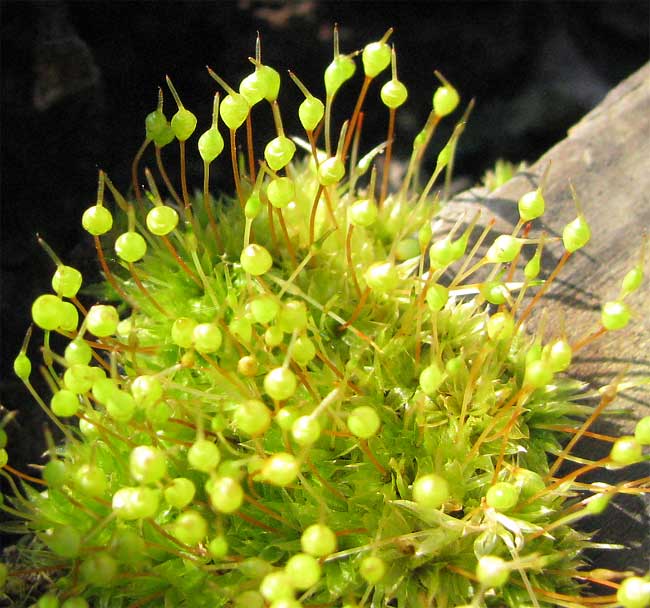Excerpts from Jim Conrad's
Naturalist Newsletter

from the February 2, 2009 Newsletter, issued from the forest near Natchez, Mississippi; elevation ~400ft (120m), ~N31.47°, ~W91.29°:
MOSS PATCH ATOP A MOLE TUNNEL
In Karen's leaf-covered backyard lawn there's a network of mole tunnels where here and there the moles have pushed up mounds from below. These elevated rises of naked dirt constitute habitats for a certain kind of very pretty, interesting moss, the one shown above.
That patch of mosses is about an inch across and each moss plant is some half an inch tall. The moss species forming the patch is one of the most abundant, easy- to-identify of all moss species, native to all continents except South America and Antarctica, and found in such frequent habitats as gardens, lawns, pastures and open woods, so it's a good species to know. It's the Common Bladder Moss, PHYSCOMITRIUM PYRIFORME. The species' size, leaf characters and capsule shape vary across its area of distribution, as well as within single populations.
Common Bladder Moss is distinguished by its nearly spherical capsules topped with long, slender "caps" typically set at angles. The green vegetative bodies consist of short, leafy stems growing so packed together that they form a mossy crust on the ground. This moss crust protects naked soil from erosion, so Common Bladder Moss is one of that special breed of organisms constituting "Nature's first responders." They move in first to stabilize disturbed soil.
Mosses are primitive plants that evolved before Nature came up with the idea of flowers, so they reproduce with spores instead of fruits and seeds. The spherical capsules shown in the picture are full of developing spores that will escape the capsule later, through a hole in the top. The moss reproductive structure is a complex, interesting thing and you might want to review how it's put together at my moss page at https://www.backyardnature.net/mosses.htm.
My field guide, available at the above link, is How to Know the Mosses and Liverworts, and I've never had much luck with it. Nearly always as I'm keying out a new moss I end up needing a microscope to see leaf-cell shape and other details my powerful handlens can't make out. To identify our Common Bladder Moss I ended thumbing through the book matching what I had with illustrations, which is a real indignity to a key-using enthusiast like myself.
If you want to try your own hand at identifying a moss using technical keys, check out the "Key to the Moss Genera of North America North of Mexico" at http://www.mobot.org/plantscience/BFNA/V1/KeyToMosses_2.htm.
But don't bother if you can't handle terms like "protonemata," "papillose setae" and "filamentous Pseudoparaphyllia."